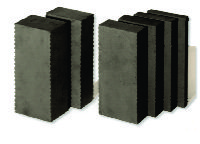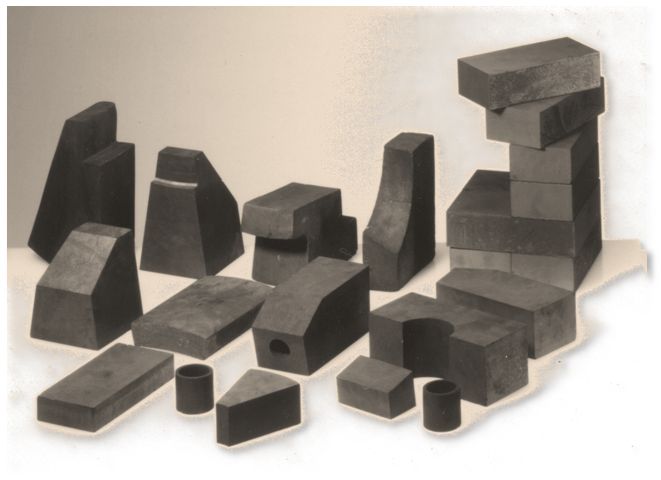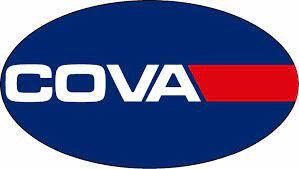STANDARD CARBON AND GRAPHITE BRICKS & SHAPES
Carbon and graphite linings have a high mechanical strength, good heat resistance and excellent stability to temperature changes. Of special importance is the universal chemical resistance. In the food processing industries, tasteless and odourless carbon materials are very valuable. As a result, carbon and graphite linings are often used within harsh chemical environments.
In many chemical processes, the apparatus and reaction vessels must be protected against the acidic and caustic materials used in the processes. Apparatus linings made from ceramic or synthetic plastic type materials are often unsuitable, since they may not withstand chemical attack, high temperatures or sudden temperature changes. Alkaline solutions and hydrofluoric acid are of great importance in chemical technology, but they rapidly destroy equipment linings not made of carbon containing materials.

STANDARD BRICKS

SHAPES
GENERAL APPLICATION INFORMATION
PHYSICAL AND MECHANICAL PROPERTIES
- Good dimensional stability (low thermal coefficient of expansion)
- Good heat conductivity
- Good corrosive resistance
- Good temperature resistance
- Good self-lubrication
- Good frictional characteristics
- Good machining characteristics
- Low weight
OPERATING TEMPERATURES
The temperature resistance in an oxidizing atmosphere can be specified as 500°C maximum for TYGRAF materials. In a non-oxidizing atmosphere the temperature resistance is determined by the final graphitizing treatment of each individual grade (e.g. upper application limit for graphite is approximately 3000°C). Temperature resistance is also affected by various impregnations. In the case of resin impregnation the maximum operating temperature is 180°C, for lead impregnation 200°C and antimony impregnation 500°C.
DIMENSIONS
a. Machined pieces e.g. tubes are manufactured in accordance with: DIN 7168 rough.
b. For special dimensions, e.g. hand moulded bricks no tolerances can be quoted and have to be agreed upon.
Besides the TYGRAF-T, TX and TXH grades, other grades of carbon and graphite in the form of beams or tubes etc., for special chemical construction applications can be supplied. The technical data of these other grades are available on request. On principle, any size and shape can be produced. Moulding methods can be block pressing, extrusion pressing, vibrating and ramming. Hand moulded bricks, both complicated and simple in form are made in the TYGRAF-T, TX and TXH grades. It is recommended to contact us when projects in this field are being planned.
Special sizes and bricks with convex radii can also be made in suitable quantities. To allow us to check the feasibility of manufacture, both quantity requirements and dimensioned drawings should be supplied.
TOLERANCES
a. Machined pieces e.g. tubes are manufactured in accordance with: DIN 7168 rough.
b. For special dimensions, e.g. hand moulded bricks no tolerances can be quoted and have to be agreed upon.
Besides the TYGRAF-T, TX and TXH grades, other grades of carbon and graphite in the form of beams or tubes etc., for special chemical construction applications can be supplied. The technical data of these other grades are available on request. On principle, any size and shape can be produced. Moulding methods can be block pressing, extrusion pressing, vibrating and ramming. Hand moulded bricks, both complicated and simple in form are made in the TYGRAF-T, TX and TXH grades. It is recommended to contact us when projects in this field are being planned.
Special sizes and bricks with convex radii can also be made in suitable quantities. To allow us to check the feasibility of manufacture, both quantity requirements and dimensioned drawings should be supplied.
THE USE OF ACID RESISTANT CEMENTS
CHEMICAL STABILITY
TYGRAF-T carbon bricks are extremely insensitive to all acids, provided they have no strongly oxidising properties. TYGRAF materials also show the same excellent resistance to attack by highest concentrations of alkaline solutions. Alternating acid and alkali conditions are withstood by this carbon material and they are also unaffected by corrosive salt solutions. TYGRAF-T carbon brick linings are thus particularly suitable for chemical processes which involve various temperature and concentration cycles.

